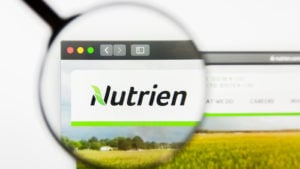Yet commodities have lagged the U.S. stock market this year, with the Bloomberg Commodity Index returning 7% since January compared to the S&P 500’s 10.5%. Nonetheless, the outlook for commodities has been improving. Supported by a stronger-than-expected global economy, potentially lower interest rates, and ongoing supply constraints, commodity prices could gain further momentum.
Whether tracking oil, gold or a broad basket of agricultural resources, commodity exchange-traded funds (ETFs) provide versatile investment options, offering a convenient way to access these assets without physical ownership. As we move into the second half of 2024, here are three top commodity stocks to buy for inflation hedging, portfolio diversification, and potential growth.
Wheaton Precious Metals (WPM)

First among the commodity stocks to buy is Canada-based Wheaton Precious Metals (NYSE:WPM). It provides a unique way to invest in precious metals like gold and silver. Unlike traditional mining companies, WPM doesn’t own or operate mines. Instead, it secures long-term contracts to buy precious metals from miners at fixed, low prices. This strategy leverages rising metal prices, potentially generating significant profits for Wheaton.
In early May, the commodity company announced first quarter results. The mining giant reported $297 million in revenue, $219 million in operating cash flow, and $164 million in adjusted net earnings. As a comparison with the year-ago quarter, earnings per share (“EPS”) were up 61.9%, reflecting tremendous progress in profitability.
Gold and silver markets have experienced a mix of volatility and growth opportunities over recent quarters. Gold, traditionally seen as a safe-haven asset, has seen increased demand due to economic uncertainty and geopolitical tensions. The result has been higher gold prices, benefiting companies like Wheaton.
As a result, WPM stock is up 12.5% year-to-date (YTD), while the dividend yield is 1.1%. At present, the shares are exchanging hands at 44 times forward earnings. Wall Street remains optimistic with an average 12-month price forecast of $60.50, an upside potential of 8.5%.
Nutrien (NTR)

We continue our commodity stocks to buy with Nutrien (NYSE:NTR). As a powerhouse in the agricultural chemicals industry, it provides essential crop inputs and services. Nutrien has rapidly grown into a global leader, offering products like potash, nitrogen, and phosphate. Through its retail network, Nutrien also delivers these products directly to growers.
In early May, the company released its metrics for the first quarter of 2024. Net earnings stood at $165 million, down from $576 million a year ago. According to management, there has been a substantial drop, in part, due to seasonal fluctuations.
A recent study suggests that the global agriculture fertilizer market size was valued at almost $215 billion in 2023. It is expected to surpass around $297 billion by 2032 with a compounded annual growth rate (CAGR) of 3.7% from 2023 to 2032. Therefore, despite the recent decline in earnings, Nutrien is likely to benefit from this global growth.
NTR stock advanced 5% YTD, while the dividend yield is a notable 3.6%. We believe the shares are undervalued at 9.70 times earnings and 1.0 times sales. Finally, the 12-month median price forecast for Nutrien is $66.30 suggesting an upside potential of 12%.
Invesco DB Agriculture Fund (DBA)

Our final commodity asset is the exchage-traded fund (ETF), Invesco DB Agriculture Fund (NYSEARCA:DBA). It offers exposure to agricultural commodity futures. Launched in January 2007, the fund has approximately $748 million in assets under management.
The global agricultural commodity market, valued at $1.6 trillion in 2022, is forecasted to reach $2.2 trillion by 2032, growing at a 3.2% CAGR. Meanwhile, agricultural commodity prices are notoriously volatile, influenced by factors such as weather conditions, geopolitical tensions, and global supply chain disruptions. For example, in 2024, cocoa prices surged by 70% and reached historical highs in March due to adverse weather conditions in West Africa, a major cocoa-producing region, while sugar prices dropped over 10% due to an anticipated global surplus in the 2024/2025 season.
DBA invests in 11 commodity futures, including cocoa (20.7%), coffee (12.6%), live cattle (11.7%), soybeans (10.7%), and corn (10.5%), rebalanced annually. It also hedges against potential price declines by investing in U.S. Treasuries.
Year-to-date (YTD), DBA has gained around 18%, reaching a 52-week high on April 24. Currently, shares trade at 10 times trailing earnings. While the total expense ratio stands at 0.93%, investors benefit from a substantial 3.9% dividend yield.
However, it’s important to caution readers that investing in futures contracts, even through an ETF, can be volatile. Thus, investors should assess whether a fund like DBA aligns with their portfolio objectives.
Most commodity ETFs primarily hold futures contracts €”agreements for future delivery rather than physical commodities themselves. Futures contracts expire monthly, unlike stocks that trade perpetually. To avoid physical delivery upon contract expiration, these funds engage in a practice known as “rolling over,” replacing expiring contracts with new ones maturing later. The process involves various strategies and combinations of futures contracts selected by the fund, with roll-over costs fluctuating daily.
Two other key terms to understand are “contango” and “backwardation.” In a contango market, the forward price of a futures contract exceeds the current spot price, leading to roll-over losses for commodity ETFs based on a futures contracts. Conversely, in a backwardation market, the forward price is lower than the spot price, often indicating a demand-supply imbalance. In such instances, there may be roll-over gains instead of losses.
Regularly transitioning to new contracts incurs varying roll-over costs that fluctuate daily. Negative roll yields, common in contango markets, can diminish long-term returns, highlighting the disparity between ETF returns and physical commodity prices. Due to these dynamics, commodity funds’ returns may deviate from physical commodity prices, with negative roll yields typically eroding returns over time. Therefore, buyer beware.
On the date of publication, Tezcan Gecgil did not have (either directly or indirectly) any positions in the securities mentioned in this article. The opinions expressed in this article are those of the writer, subject to the InvestorPlace.com Publishing Guidelines.
Tezcan Gecgil, PhD, began contributing to InvestorPlace in 2018. She brings over 20 years of experience in the U.S. and U.K. and has also completed all 3 levels of the Chartered Market Technician (CMT) examination. Publicly, she has contributed to investing.com and the U.K. website of The Motley Fool.
